Timber Windows: Comprehensive Guide for Types, Cost & More
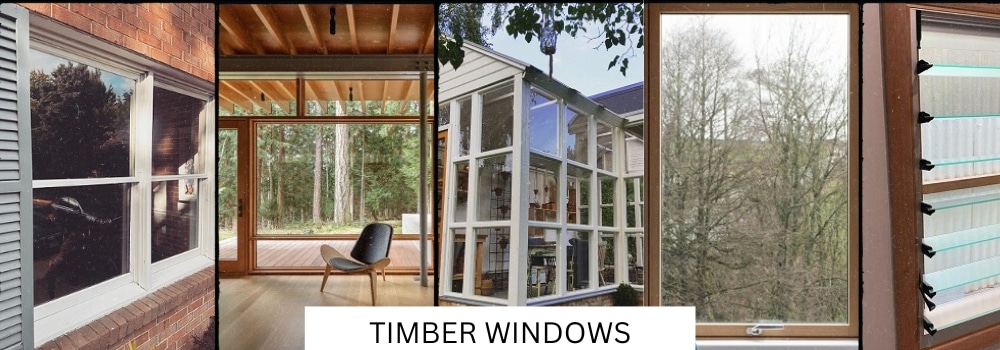
As a 30-year veteran in the glazing industry, I’m excited to share with you the elegance and practicality of timber windows. In this guide, I’ll take you straight into the essential aspects you need to know: why timber windows are a popular choice, their maintenance requirements, the different types of wood for windows, and considerations regarding cost. Let’s explore together how timber windows can add a timeless charm to your home.
Key Takeaways:
- Timber windows add timeless beauty and value to any structure.
- They provide excellent insulation, contributing to energy efficiency.
- Regular maintenance ensures longevity and performance.
- Choosing the right timber type is crucial for specific needs and environments.
- Timber windows are an eco-friendly and sustainable choice.
Timber Windows - Pros & Cons
- Aesthetic Appeal: Timber windows have a natural grain and texture that add elegance and warmth to homes, enhancing both modern and traditional architectures.
- Insulation Properties: As a natural insulator, timber windows contribute to maintaining comfortable indoor temperatures, thus reducing energy costs.
- Customization and Variety: Offering versatility in design, timber windows can be customized in various shapes, sizes, and colors to match specific homeowner preferences.
- Environmental Benefits: Being a renewable resource, timber has a lower carbon footprint and, with proper maintenance, can have a long lifespan, contributing to environmental sustainability.
- Maintenance Requirements: Regular maintenance, including painting and staining, is necessary to protect timber windows from weather elements and ensure their longevity.
- Potential for Rot and Warping: Timber can be susceptible to moisture if not properly maintained, leading to potential rot, warping, or other weather-related damages over time.
- Initial Cost: The upfront cost of timber windows can be higher compared to alternatives like uPVC or aluminum, influenced by the type of wood and customization requirements.
Comparison With Other Window Types
| Material | Cost | Maintenance | Durability | Aesthetic |
|---|---|---|---|---|
| Timber | Higher initial cost | Regularly | High with care | Natural, elegant |
| Aluminum | Lower initial cost | Minimal | Very durable | Modern, sleek |
| uPVC | Moderate | Minimal | Durable | Contemporary |
For an in depth comparison on different window materials, check out our article about comparisons between Timber, Aluminium & uPVC windows.
Best Types of Wood for Windows
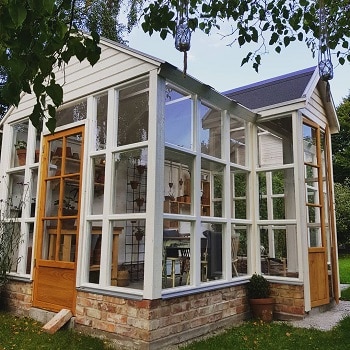
| Pine | |
|---|---|
| Durability | 6 |
| Maintenance | 5 |
| Aesthetic | 7 |
| Affordability | 9 |
Common and affordable softwood, easy to work with but requires regular maintenance
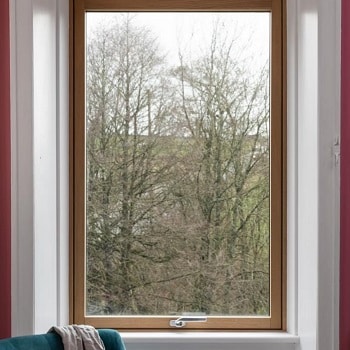
| Oak | |
|---|---|
| Durability | 9 |
| Maintenance | 6 |
| Aesthetic | 8 |
| Affordability | 6 |
Strong and durable hardwood, more expensive, resists warping and shrinking

| Teak | |
|---|---|
| Durability | 10 |
| Maintenance | 8 |
| Aesthetic | 9 |
| Affordability | 5 |
Extremely durable, resistant to decay and termites, water-resistant, ideal in humid or rainy areas.
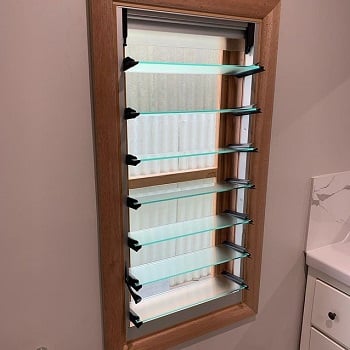
| Cedar | |
|---|---|
| Durability | 7 |
| Maintenance | 7 |
| Aesthetic | 8 |
| Affordability | 7 |
Lightweight softwood, decay-resistant, naturally insect-repellent, less prone to warping.
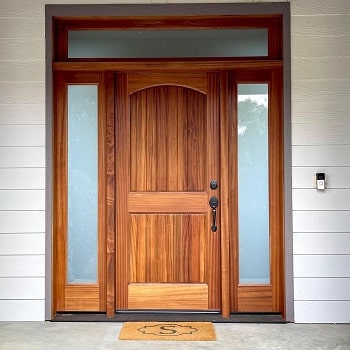
| Mahogany | |
|---|---|
| Durability | 9 |
| Maintenance | 6 |
| Aesthetic | 10 |
| Affordability | 4 |
Durable hardwood, reddish-brown, rot-resistant, often used in luxury homes.
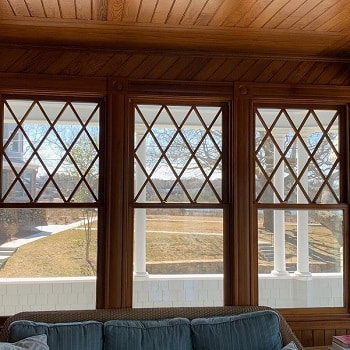
| Douglas Fir | |
|---|---|
| Durability | 8 |
| Maintenance | 7 |
| Aesthetic | 7 |
| Affordability | 8 |
Stronger than many hardwoods, light color, takes stains well, versatile for window frames.
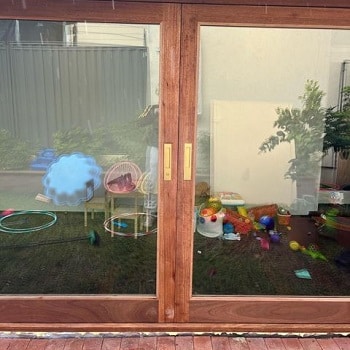
| Meranti | |
|---|---|
| Durability | 7 |
| Maintenance | 6 |
| Aesthetic | 8 |
| Affordability | 6 |
Mahogany alternative, hardwood in light to dark red, moderately durable, visually appealing and often used in luxury homes.
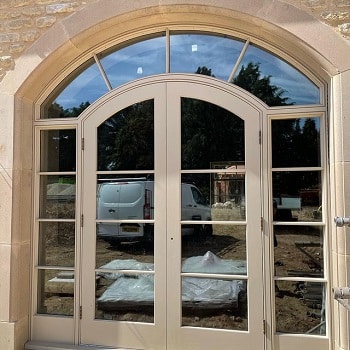
| Accoya | |
|---|---|
| Durability | 10 |
| Maintenance | 9 |
| Aesthetic | 9 |
| Affordability | 3 |
High-performance, treated for enhanced durability and rot resistance, eco-friendly, ideal for quality window frames.
What are Timber Windows?
Timber windows are window frames that are constructed using wood. The term ‘timber’ refers to the wood used for construction purposes, and in the case of windows, it is used to create the frames and sashes. They can be made from various types of wood, including pine, oak, cedar, and more, and can be customized in different styles, shapes, and finishes, making them highly versatile.
In Australia, timber windows have a rich history. They have been used for centuries in both traditional and contemporary architecture. The availability of various native timbers and the country’s favorable climate made wood an ideal material for window construction. Timber windows have been a hallmark of Australian colonial architecture, and their popularity continues to this day. Modern Australian homes often incorporate timber windows for their natural aesthetic and ability to blend seamlessly with various architectural styles.
Costs Associated with Timber Windows: A Comprehensive Breakdown
Initial Investment: There is significant upfront cost depending on wood type, design, and customization. Premium timber and complex designs lead to higher prices.
Ongoing Maintenance Costs: Timber windows require regular maintenance including costs for paint, stain, and sealants. Budgeting for professional services is also essential to prevent rot and warping.
Replacement and Longevity: Despite a long lifespan, timber windows will need eventual replacement. Costs include new windows and installation.
Comparative Perspective: While the initial cost is higher than alternatives like aluminum or uPVC, timber windows offer better insulation and aesthetic appeal, contributing to long-term value for your home.
Maintaining Timber Windows
Timber Window Maintenance Checklist:
- Regular Inspection: Check for wear and tear every 6 months.
- Painting/Sealing: Apply a fresh coat of paint or sealant annually to protect from moisture.
- Cleaning: Clean windows regularly to prevent dirt buildup.
- Professional Checkup: Consider a professional inspection every 2-3 years for structural integrity.
There are several types of timber that are commonly used for window frames, each with its own unique properties and characteristics.
Case Studies
Case Study: Strata Complex Upgrade, Coogee NSW
In Coogee, NSW, a strata committee representing a residential complex chose oak timber windows for a renovation project. The oak windows enhanced the building’s aesthetic appeal, improved insulation, and added a touch of luxury. The upgrade was well-received by residents and positively impacted property values, with the strata committee earning accolades for their decision.
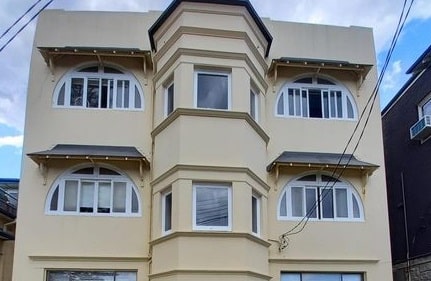
Case Study: Heritage Home, 1 John St, Ashfield NSW 2131
A heritage home in Ashfield, NSW, owned by the Thompson family, was undergoing restoration. The family wanted to retain the historical charm while improving the home’s energy efficiency. They opted for timber windows made from Meranti wood. The Meranti timber windows maintained the classic aesthetic while significantly improving insulation. The Thompsons were thrilled with the result, as the windows enhanced the home’s historical beauty and reduced energy costs.
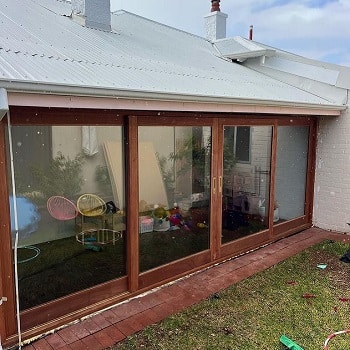
FAQ
Are Vinyl & Upvc windows the same thing?
Yes, in Australia and many other parts of the world, the terms “vinyl windows” and “UPVC windows” are often used interchangeably to refer to the same type of windows. Both terms refer to windows that have frames made from a particular type of plastic known as Unplasticized Polyvinyl Chloride (UPVC).
Are UPVC Windows Soundproof
UPVC windows are excellent at reducing noise levels. Their insulation properties not only apply to temperature but also to sound, making them ideal for homes in noisy areas.
Can You Paint UPVC Windows?
Yes, UPVC windows can be painted, but it is essential to use the right type of paint and primer to ensure that the paint adheres properly to the UPVC surface.
How long do UPVC windows last?
UPVC windows are known for their durability and can last for around 20-25 years or more with proper maintenance.
Are UPVC fire resistant?
UPVC material is fire retardant, meaning that it does not support combustion and will self-extinguish if exposed to fire.
Do UPVC windows discolour over time?
High-quality UPVC windows are resistant to discoloration. However, lower quality UPVC may become slightly discolored or fade over a long period, especially when exposed to harsh sunlight.
Are UPVC windows environmentally friendly?
UPVC windows are energy efficient, which is beneficial for the environment in terms of reducing energy consumption. However, as a plastic, UPVC is not biodegradable and recycling options are limited compared to materials like aluminum.
What kind of maintenance do UPVC windows require?
UPVC windows require minimal maintenance. Cleaning the frames with a mild detergent and water a few times a year is usually sufficient. It’s also a good idea to occasionally lubricate the hinges and locks.
Conclusion
UPVC windows are an excellent investment for any homeowner. They offer a range of benefits including durability, energy efficiency, and security. However, like any investment, it’s important to do your research and choose quality products and installation services.
As a seasoned glazier currently working with Splendid Window Glass Repairs, I can personally vouch for the long-term benefits of UPVC windows, especially in the diverse Australian climate. If you are considering UPVC windows for your home, I highly recommend consulting with experienced professionals who can guide you through the selection and installation process.
For more information on our window installation service, feel free to reach out to us on 02 8880 6429
Final Thoughts
Timber windows are an investment that can add value and beauty to your home or building. With proper care and maintenance, they can last for decades. It’s important to weigh the pros and cons and consider your specific needs and preferences when making a decision in the windows you choose. If you are looking for a timeless, elegant option and are willing to inuvest in maintenance, timber windows are an excellent choice.
Thank you for taking the time to read this article. If you have any further questions or need professional advice or installation services, don’t hesitate to reach out to us at Splendid Window Glass Repairs.

Phillip Sharp has spent more than three decades honing his skills as a glazier in Sydney. He is currently employed at Splendid Window Glass Repairs, where he specializes in glass replacement and repair in the Sydney Eastern Suburbs area. With his wealth of experience and commitment to excellent craftsmanship, Phillip is highly respected in the industry and trusted by clients to provide top-quality work.
